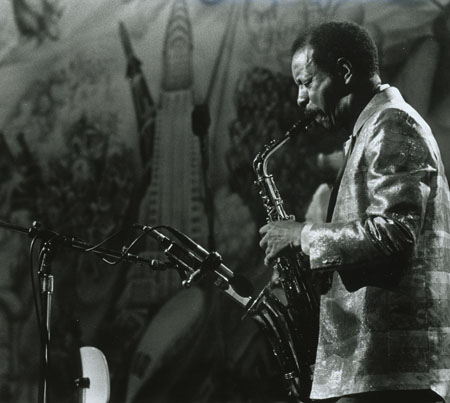“The restoration and reissue of Ornette: Made in America, Shirley Clarke’s 1985 portrait of Ornette Coleman, the saxophonist whose recordings and performances in the late ’50’s and early ’60’s were among the most liberating avant-garde breakthroughs in the history of jazz (and who, happily, is still performing, at the age of 82), is cause for celebration—both for its value as a movie and for its exploration of Coleman’s art.” So begins an entry from Richard Brody, accompanied by a clip (2’43”) and a link to his capsule review in the New Yorker. “There’s a lot more to say about it, particularly regarding the way that Clarke uses video technology and dramatic reconstructions to evoke Coleman’s way of thinking, but here I’d like to focus on Coleman’s music—which I’ve been passionate about since I was in high school, in the ’70’s, and still listen to enthusiastically—while noting the ways in which the movie contributes to a better understanding of the music.”
Do read on, but for now, Melissa Anderson in the Voice: “The invaluable—yet still insufficiently appreciated—American independent filmmaker Shirley Clarke (1919–97) once said: ‘There is no real difference between a traditional fiction film and a documentary. I’ve never made a documentary. There is no such trip.’ Her genre-blurring claim applies equally to her first feature-length project, 1962’s The Connection—a film within a film about an uptight ofay documentarian chronicling a multiracial group of smack addicts, many of them jazz musicians, living in a squalid Manhattan loft—as to her fifth and last, 1985’s Ornette: Made in America, a funky, nonfiction tribute to the great avant-garde saxophonist Ornette Coleman that upends the staid portrait-of-the-artist formula. The second impeccably restored release this year—following The Connection—of Milestone Films’ vital Project Shirley, Ornette: Made in America tinkers with and discards the conventions of the bio doc just as its pioneering musician subject exploded those of jazz.”
This is “the movie she was born to make,” argues J. Hoberman at Artinfo; it’s “something of a revelation, a summarizing work that draws on virtually everything the pioneering independent made before…. A triumph of editing, at once jagged and fluid, Ornette skitters back and forth in time, with side trips to Morocco and Nigeria, integrating Clarke’s ’60s footage, as well as other material shot on video, with newer Super-16 and 35mm material from the ’80s. At least half is devoted to Coleman in performance, mainly with his ensemble Prime Time, but there are also cameos by William Burroughs, Don Cherry, King Curtis, Yoko Ono, and music critic Robert Palmer, along with numerous comments by Coleman himself offered at various stages in his life. Taking about his youth in Texas, Coleman makes reference to his decision to ‘pursue my career imitating music.’ Truly inspired, Clarke’s movie imitates that imitation, finding an approach that is perfectly wedded to her material.”
“But Clarke’s experimentation fails often enough for one to wonder if jazz’s spontaneous essence simply can’t be translated into an art form as necessarily meticulous as film,” finds Joseph Jon Lanthier, writing in Slant.
“Clarke’s instincts serve her well,” counters Keith Uhlich in Time Out New York. “In one particularly inventive scene, she counterpoints a Coleman tune with the beeps and blips of arcade games—an aesthetic masterstroke that manages to capture this vital performer’s essential alienness as well as sum up both artists’ incessant originality.”
“Be it the lyrical prose of Toni Morrison, the cadenced dialogue of David Mamet, or the free-form cinematography of the Maysles Brothers—to name but a few—there are a handful of rare, brilliant artists who have repurposed the sounds and rhythms of jazz (and rock, and classical) to their own ends,” writes David Fitzgerald in Cinespect, and “we can now add the visionary direction and frenetic editing of dancer/choreographer/avant-garde American filmmaker Shirley Clarke to that short list.”
Ornette: Made in America is at the IFC Center through Tuesday and will soon be moving on to more cities in the States.
Update, 9/2: “What makes the movie thrilling beginning to end is the score that Coleman himself wrote for it, largely derived from one of his major works, Skies of America (1972), a composition for symphony orchestra and free-jazz combo,” notes Amy Taubin, writing for Artforum. “Ornette: Made in America is a movie about process: Coleman’s process of making music and Clarke’s process of using the moviemaking apparatus to convey something about his method of making music and living in the world.”
For news and tips throughout the day every day, follow @KeyframeDaily on Twitter and/or the RSS feed. Get Keyframe Daily in your inbox by signing in at fandor.com/daily.




